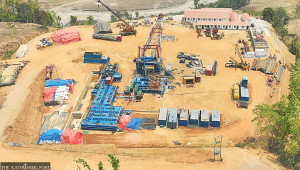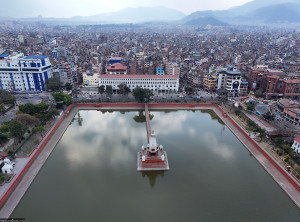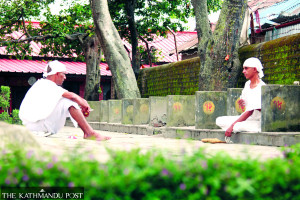Opinion
Something to be proud of
Social security allowances can be an important vehicle for strengthening social contract between state and citizens
Rasmus Schjoedt & Subindra Bogati
Since the introduction of the old age allowance in 1994, successive governments have gradually established a tax-financed social security system that is very impressive for a country at Nepal’s level of income. Nepal’s social security system includes the allowances for older people, widows/single women, people with disabilities, children (Dalits and all children in the Karnali zone) and endangered indigenous groups. Together, these programmes provide much better support for the people of Nepal than the social security systems of much larger and wealthier countries such as India or Indonesia.
Nepal’s social security allowances have proven to be popular. As a result, political parties are competing to expand the programmes to win voters’ favour. This was also apparent in the recent local elections, with many candidates promising to increase the social security allowances for senior citizens.
It’s not populism
Although the central government has made it clear that local authorities cannot use the grant to increase social security allowances on their own, it would be a mistake to dismiss election promises to expand the allowances as populism or political opportunism. Rather, the gradual expansion of programmes and increase of benefit levels over the years show how competition between parties in democratic elections is leading to the introduction and expansion of programmes popular among voters. This is the very function of elections, and it is a positive sign that this dynamic is now also showing itself in the local elections.
Last year, the government doubled the benefit levels of all the social security allowances, and Nepal’s old age allowance is now among the most generous in the region. Increasing the old age allowance further may therefore not be the best way to improve the social security system at the moment. Instead the government should follow international best practice and index the benefit levels to prices. At the moment, it is a problem that the real value of the allowance is quickly reduced as a result of inflation.
There are other flaws in the system that need to be addressed, including the exclusion of a substantial number of eligible people. Our own analysis, comparing an estimate of the likely number of beneficiaries with the actual number of people registered, shows that coverage rates are likely to be high among older people and widows/single women. The problem of exclusion is much worse among Dalit children. Comparing the number of eligible beneficiaries with the number of actual beneficiaries, we estimate that as many as one in five of the eligible children could be missing out on the allowance. The main issues remain lack of birth registration and a long waiting time for registration. In other cases, parents are simply not aware of the programme as a result of inadequate provision of information by local authorities.
However, the biggest issue of exclusion concerns people with disabilities.
We do not know exactly how many people should receive the disability allowance, but based on international estimates of the number of people with disabilities in Nepal by the World Health Organisation, it is likely that 9 out of 10 people with disabilities in need of support are not receiving the allowance. There is an urgent need to reform the disability assessment process to make it more accessible and in compliance with international standards, as defined in the United Nations Conventions on the Rights of Person with Disabilities, which Nepal ratified in 2010. In addition, the Supreme Court has ruled that people with severe disabilities should receive at least Rs3,000-5,000 per month, in order to cover their full living costs. However, the government has yet to act in accordance with this verdict.
There are other issues with the way the programmes are currently designed. For example, Dalits receive the pension from the age of 60, while everybody else have to wait until they reach 70. While this makes sense, given that Dalits have much lower life expectancy than other groups, the lower eligibility age for Dalits creates dissatisfaction among other groups and risks increasing the already existing animosity and discrimination against Dalits. The best way to improve the old age allowance at this point would therefore be to lower the age of eligibility from 70 to 60 for everybody.
Universal targets
The child allowance faces the same issue, being only available for Dalit children, with the exception of children living in the Karnali zone. It is therefore very positive that the government in 2016 committed to gradually making the child allowance universal across the country.
In general, a major issue for the social security programmes is the low administrative capacity of the frontline government officials who are responsible for delivering the cash to beneficiaries. In some areas, one VDC Secretary has been responsible, in addition to their other duties, for delivering the benefits in three to four VDCs.
The social security allowances are the only government programmes that are expected to be delivered without any budget allocated for administration. This is clearly not feasible, and the government should take the opportunity of the new administrative system to drastically increase investment in administrative capacity at the local level. This should include investing in information campaigns to ensure that everybody is aware of which services they are entitled to.
One of the enviable characteristics of Nepal’s social security allowances is that they are universal, rather than poverty targeted. Experience from other low-income countries shows that poverty targeting inevitably creates conflicts between beneficiaries and non-beneficiaries, and that it is not possible in practice to accurately identify ‘the poor’.
We have also found in our own field research that because the eligibility criteria of the allowances are very simple and transparent, the money is not misused for political patronage, as often happens with the more flexible development funds.
Recent research by New Era and others also shows that most of the money reaches the right people, even if there are often delays in payments. It is clear that the social security allowances are a very effective way for the Nepali state to provide direct support to the people. However, more investment in administrative capacity is needed to improve timely delivery of payments.
A new World Bank funded project promises to streamline the payment process by introducing bank payments and biometric identification systems. However, this needs to be introduced very carefully to ensure that the payments will be as accessible as they are under the current system. At the moment, payments may be late, but they are at least delivered close to people’s homes, and sometimes even directly to people’s doorstep, for those who are not able to make it to the pay point.
In addition, the introduction of payments through private service providers could risk weakening the link between citizens and the state. For many beneficiaries, the payment of the allowance is their only contact with a government official, and the manual payment system therefore also serves the purpose of strengthening relations between citizens and the state. When complemented with social accountability mechanisms such as public hearings or social audits, the social security allowances can therefore be an important vehicle for strengthening the social contract between the state and the citizens.
In sum, Nepal’s social security allowances are something to be proud of, but more funds need to be invested in strengthening the administration of the programmes, and particularly in increasing access to the disability allowance.
Bogati is the Chief Executive of Nepal Peacebuilding Initiative; Schjoedt is a social policy specialist with Development Pathways, a UK-based consultancy firm




 19.67°C Kathmandu
19.67°C Kathmandu











